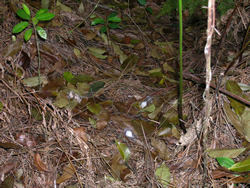
Baited vials.
Baited Vials (Pottles)
This is a commonly used technique, and has gained wide acceptance in New Zealand for surveillance and monitoring. We recommend this technique for surveillance and monitoring.
Typically a non-toxic bait is placed into a small plastic vial. The bait attracts ants, who recruit other ants to come and collect the bait and take it back to their nest. Types of baits that we recommend for use include (see Control section).
Baited vials are placed out of the sun with lid off for a minimum of 3 hours. Baits can be left out for quite a long period depending on your specific conditions, even up to 24 hours. However, the longer vials are left out means the bait will more likely dry out and become unpalatable, or vials may be vandalised. Vials are usually spaced about 10 m apart, in groups of 10–20 vials. However, for more intense monitoring, spacing can be reduced to less than 5 m apart. Vials need to be plastic (to reduce breakage) and numbered so that specific locations can be found again if Argentine ants are detected. Baiting gives information on presence and absence of Argentine ants. In addition, it can also gives a rough indication of abundance. Note: ant abundance is extremely difficult tio measure accurately (because it is so variable), so ant abundance in baits should be treated only as a rough guide.
The advantages of baiting are:
- Baiting is an easily learned technique
- A number of sites can be visited in a single day
- Can assess effectiveness of control programmes using recruitment counts
- No identification skills required for initially placing baits out
- Non-toxic bait indicates likely acceptance rate of toxic bait (can use as a prefeed)
The disadvantages of baiting are:
- A return visit is needed (to place out, and then pick up vials)
- Cost of equipment including bait and vials (can be washed and recycled)
- Cost of time to: (i) set up numbered grids with numbered vials, and (ii) remove ants from vials in the laboratory
- False negatives, where ants are present but are not attracted to the bait (e.g. seasonal preference for food, abundant resources already available)
- Vandalism can occur, particularly in urban areas, with people (generally trying to tidy up!), dogs and pukeko
- Wide spacing may miss smaller ant colonies
- Some non-target catch, mostly other ants
|
|
|
|

 Direct searching
Direct searching Baited vials
Baited vials Baited tiles
Baited tiles Pitfall traps
Pitfall traps